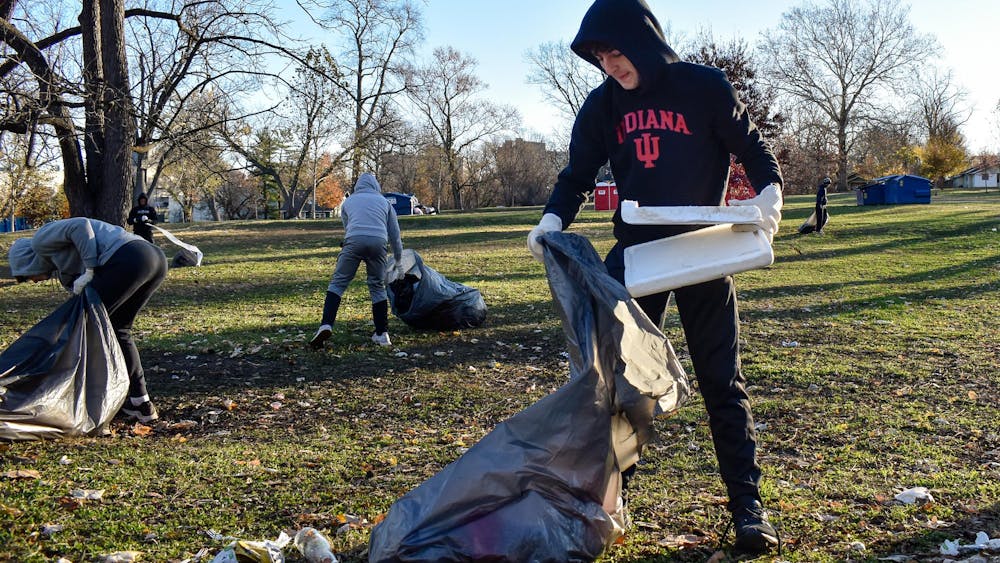The answer is Will Shortz, king of crosswords and whiz of wordgames.
He’s the nation’s puzzlemaster: he edits New York Times crosswords and is the host on National Public Radio’s Sunday Puzzle, where he poses word games similar to the one above. He also founded the American Crossword Puzzle Tournament.
Or, as third year journalism student David Pecar put it, “Will Shortz is a rockstar.”
Shortz gave a talk titled “The Art of the Puzzle” Wednesday night at the Whittenberger Auditorium in the Indiana Memorial Union.
“Crosswords are objectively good for you,” Pecar told his friend while they waited for the talk to begin. “It’s solid pabulum.”
Pabulum is sustenance for the brain.
Shortz sold his first puzzle when he was 14 years old. When he started at IU, he continued to focus on puzzles. He developed his own major. He said he’s the only person in the world with a degree in enigmatology.
“I repopularized the word,” Shortz said. “If you google the word ‘enigmatology,’” I am the first entry.”
Shortz said he is thankful he came to IU because it allowed him to create his own major.
“I convinced them that puzzles were a serious field of academic inquiry,” Shortz said. “IU had no courses on puzzles when I was here. Still don’t in fact — it’s a big gap.”
In college, Shortz took courses on anagrams, math puzzles, logic puzzles, magazines puzzles and the psychology of puzzles. He would make a new crossword every week, take it in to his professor and sit by him as the professor solved and critiqued it. His thesis was on the history of American word puzzles before 1860.
Shortz began editing New York Times crossword puzzles in 1993. He receives 75 submissions a week and spends most of his working time responding to puzzle constructors. He gives them feedback explaining what they can do to make the puzzles better, and he reworks the puzzles. On average, he said, about half the clues are his.
Constructors of day puzzles receive $300. Sunday puzzles, which are much longer, get $1,000. Only about 10 percent of puzzles are accepted.
“We are living in the golden age of crosswords,” he said. “You could spend all day doing crosswords.”
Shortz said he also enjoys cryptic crosswords from Britain and KenKen.
He explained the basic rules of crossword puzzles: they must be symmetrical and visually appealing, no words can repeat, two letter words are not allowed, all the words must interlock and the puzzle should contain interesting and fresh words. There must be a minimum of obscurity and crossword-ese, and every answer must be a real word or phrase.
In one of his favorite puzzles, “Night Lights,” some of the clues required filling in little stars representing the letters STAR. In the middle of a diagram, the puzzle answer was big dipper, and the stars in the puzzle were in the shape of the big dipper.
He sometimes includes playful and even deceptive clues. In one example, the black blocks of a puzzle formed the letters L, I, E and S. An answer at the bottom of the puzzle was “10,” and its clue was the number of clues in this puzzle that contain factual errors. One of the incorrect clues was “FE” (the symbol for iron) but the answer was neon, and another clue was “typical office closing time,” with the answer 9 a.m.
He told another story of a marriage proposal via crossword. He managed to work the couple’s names into the puzzle. One of the answers was “A Modest Proposal.”
“Crosswords, like movies and life and everything else, should reflect life,” Shortz said.
And he’s responsible for helping crosswords reflect life more fully; he introduced modern cultures into the New York Times. His predecessor’s puzzles were largely vocabulary tests.
Shortz will give a lecture titled “Sam Loyd: Puzzle King” at 5:30 p.m. today in the Lilly Library.





